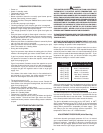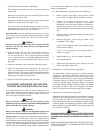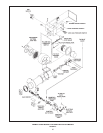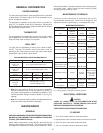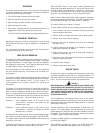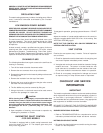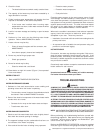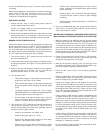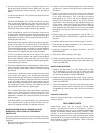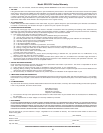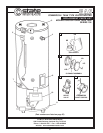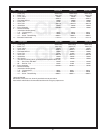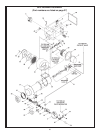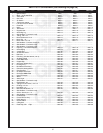
30
2. Check the fuses.
• The electrical disconnect switch usually contains fuses.
3. The capacity of the heater may have been exceeded by a
large demand for hot water.
4. Colder incoming water temperature will lengthen the time
required to heat water to the desired temperature.
• If the heater was installed when incoming water
temperature was warm, colder water creates the effect
of less hot water.
5. Look for hot water wastage and leaking or open hot water
faucets.
6. Sediment or lime scale may be affecting water heater
operation. Refer to MAINTENANCE for details.
7. Heater or burner may be dirty.
• Clean all heater flue pipes and flue connector, see
MAINTENANCE.
• Have burner properly cleaned and readjusted.
8. Burner may not be firing at proper rate.
• Check gas pressure
9. Burner fan wheel may be dirty.
• Clean fan wheel with a soft brush.
10. Reset button on high limit control (Figure 1) has operated.
Press reset button.
WATER IS TOO HOT
1. Refer to WATER TEMPERATURE CONTROL.
WATER HEATER MAKES SOUNDS
1. Sediment or lime scale accumulation cause rumbling and
pounding noises when the heater is operating.
• The sounds are normal, however, the tank bottom should
be cleaned. Refer to MAINTENANCE for details.
2. Some of the electrical components of the water heater make
sounds which are normal.
• Contacts click or snap as the heater starts and stops.
• Transformers often hum.
WATER LEAKAGE IS SUSPECTED
1. Check to see if the water heater drain valve is tightly closed.
Also check the cleanout opening for leakage.
2. The apparent leakage may be condensation that forms on
cool surfaces of the heater and piping.
3. If the outlet of the relief valve is leaking it may represent:
• Excessive water pressure
• Excessive water temperature
• Faulty relief valve
Excessive water pressure is the most common cause of relief
valve leakage. It is often caused by a “closed system”. If a check
valve, back flow preventer, or pressure-reducing valve is in the
inlet system it will not permit the expanded hot water volume to
equalize pressure with the main. The relief valve must release
this water or the water heater or plumbing system will be
damaged. Refer to MAINTENANCE – RELIEF VALVES.
When such a condition is encountered, local codes or inspection
agency should be consulted to determine which system is
acceptable in your area. These may consist of:
• Installation of a second relief valve with lower setting than the
primary relief valve.
• An expansion tank of suitable size and pressure rating and
provision to avoid water logging.
HOT WATER ODOR
On occasion, hot water may develop a strong odor. If this occurs,
drain the heater completely, flush thoroughly, and refill. If the
problem persists, chlorinating of the heater and replacement of
the factory installed magnesium anodes with aluminum anodes
may correct the condition.
Occasionally water softener companies recommend removal of
heater anodes for odor reasons.
CAUTION
Unauthorized removal of the anode(s) will void the warranty.
For further information contact your dealer.
TROUBLESHOOTING
WARNING
JUMPING OUT COMPONENTS AND/OR CIRCUITS DURING
TROUBLESHOOTING CAN CAUSE SERIOUS PROBLEMS WITH
THE POWER BURNER’S OPERATING SEQUENCE AND IGNITION
SAFETY. IF YOU DO NOT HAVE THE PROPER TEST EQUIPMENT,
I.E. A VOLT-OHM METER AND A MICRO-AMMETER DO NOT
ATTEMPT TO TROUBLESHOOT OR REPAIR STATE EQUIPMENT.
ALTERING THE IGNITION MODULE AND/OR CONTROL BOX
WIRING IN ANY WAY COULD RESULT IN INTERNAL DAMAGE TO
THE MODULE CIRCUITS, POSSIBLY ALTERING THE IGNITION
SEQUENCE ALLOWING GAS VALVES TO OPEN BEFORE THE
HOT SURFACE IGNITER IS UP TO IGNITION TEMPERATURE.
NOTE: ANY BYPASS OR ALTERATION OF THE UNITS SAFETIES
WILL RESULT IN VOIDING THE APPLIANCE WARRANTY.
Before performing any troubleshooting familiarize yourself with
the particular appliance. State power burners are supplied with
Honeywell
®
ignition control systems and Robertshaw
®
gas
control valves, see Figures 10 and 11.
Refer to the SEQUENCE OF OPERATION and burner exploded
view, see Figure 12 and the wiring diagram located on page 20,
®Honeywell is a registered trademark of Honeywell International Inc.




